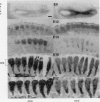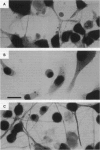Abstract
Developing animals are more sensitive than adults to acute cholinergic toxicity from anticholinesterases, including organophosphorus pesticides, when administered in a laboratory setting. It is also possible that these agents adversely affect the process of neural development itself, leading to permanent deficits in the architecture of the central and peripheral nervous systems. Recent observations indicate that organophosphorus exposure can affect DNA synthesis and cell survival in neonatal rat brain. New evidence that acetylcholinesterase may have a direct role in neuronal differentiation provides additional grounds for interest in the developmental toxicity of anticholinesterases. For example, correlative anatomic studies show that transient bursts of acetylcholinesterase expression often coincide with periods of axonal outgrowth in maturing avian, rodent, and primate brain. Some selective cholinesterase inhibitors effectively suppress neurite outgrowth in model systems like differentiating neuroblastoma cells and explanted sensory ganglia. When enzyme expression is altered by genetic engineering, acetylcholinesterase levels on the outer surface of transfected neurons correlate with ability to extend neurites. Certain of these "morphogenic" effects may depend on protein-protein interactions rather than catalytic acetylcholinesterase activity. Nonetheless, it remains possible that some pesticides interfere with important developmental functions of the cholinesterase enzyme family.
Full text
PDF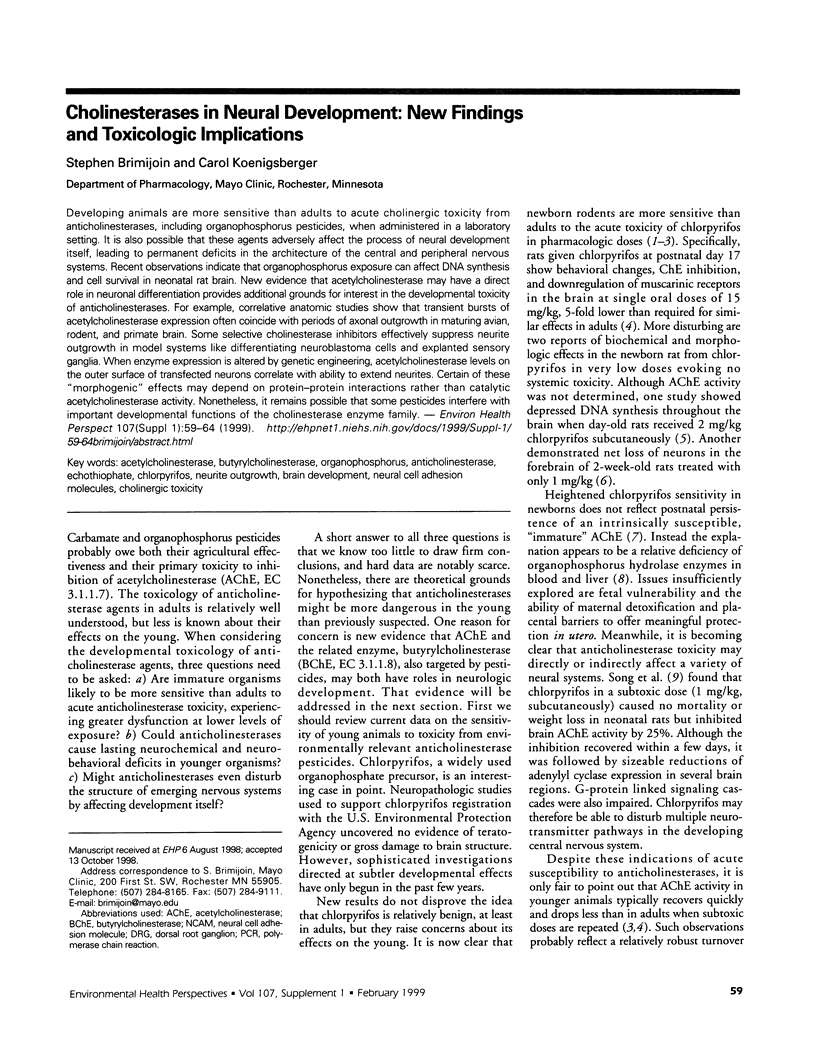
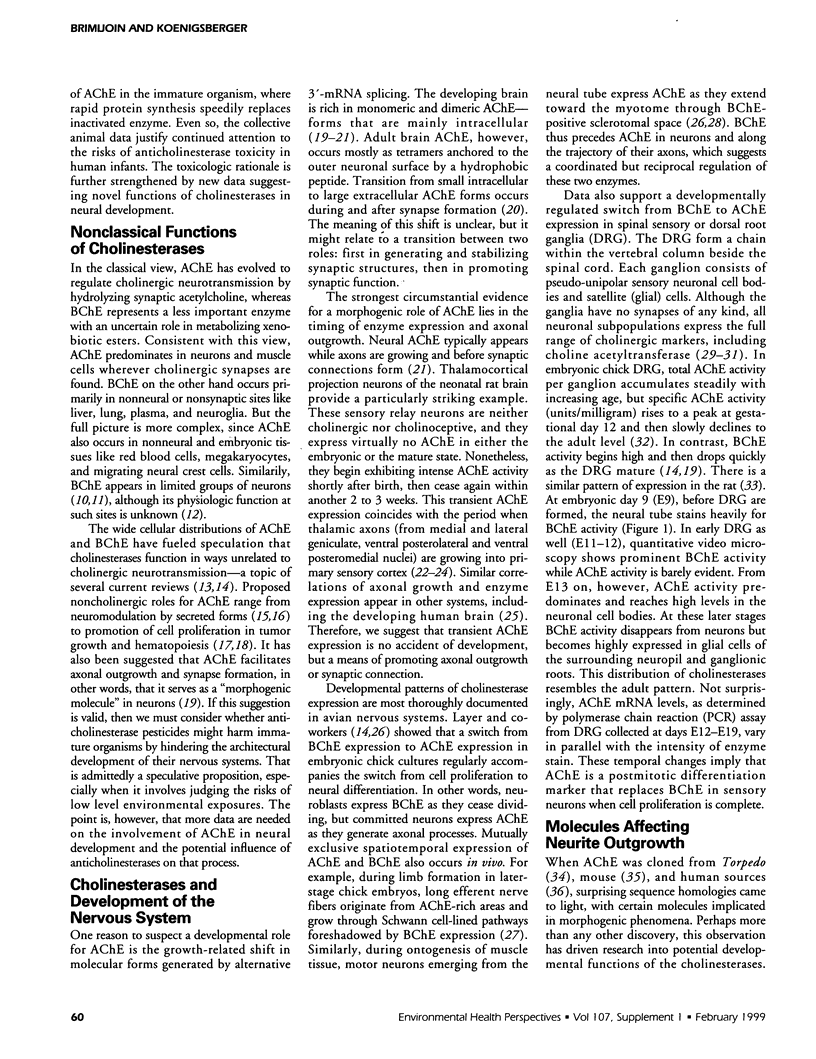
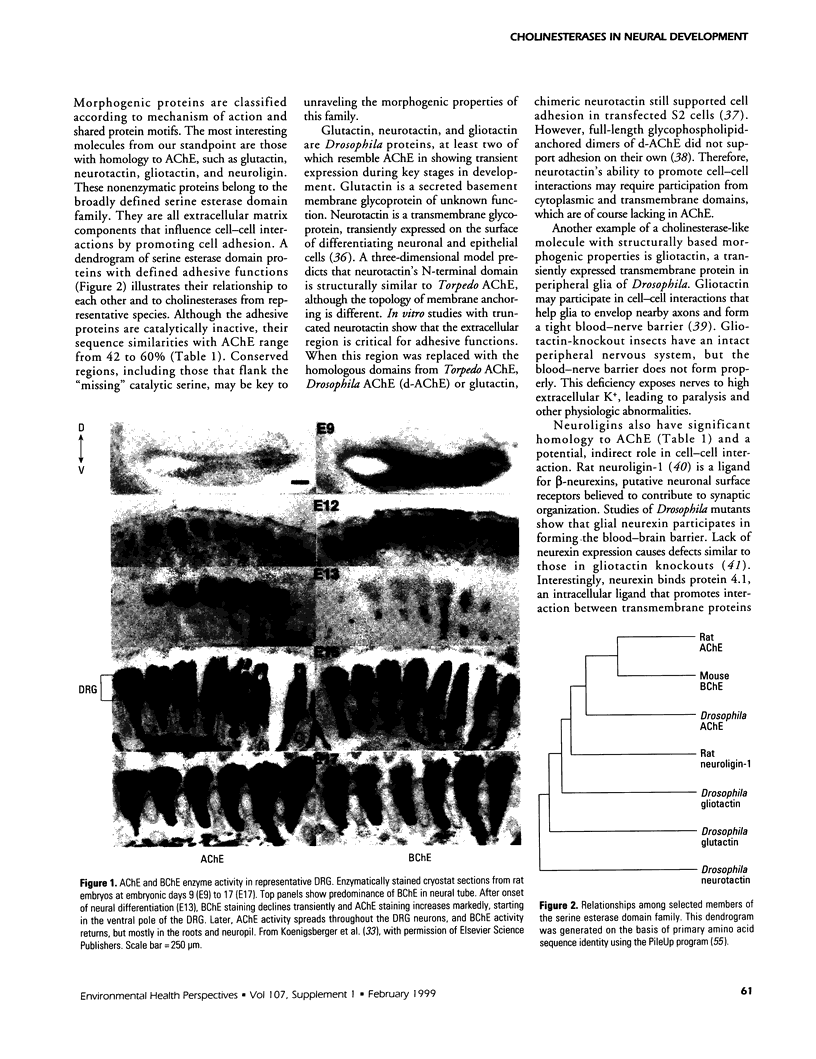
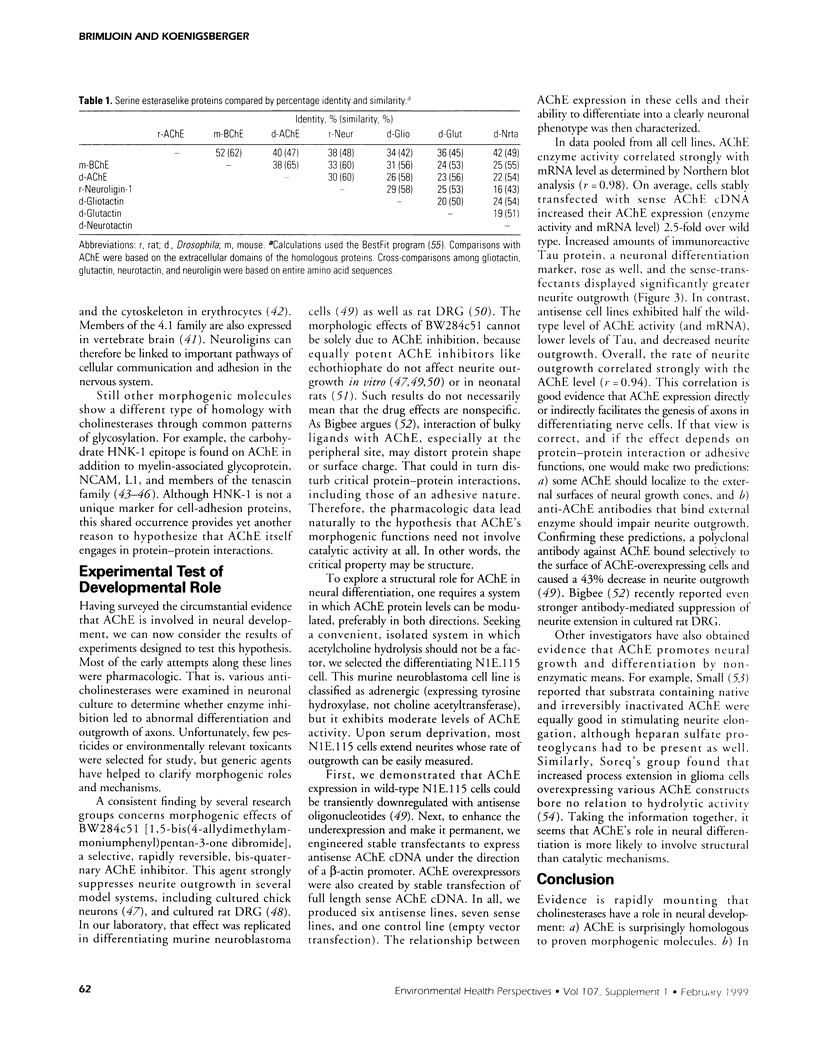
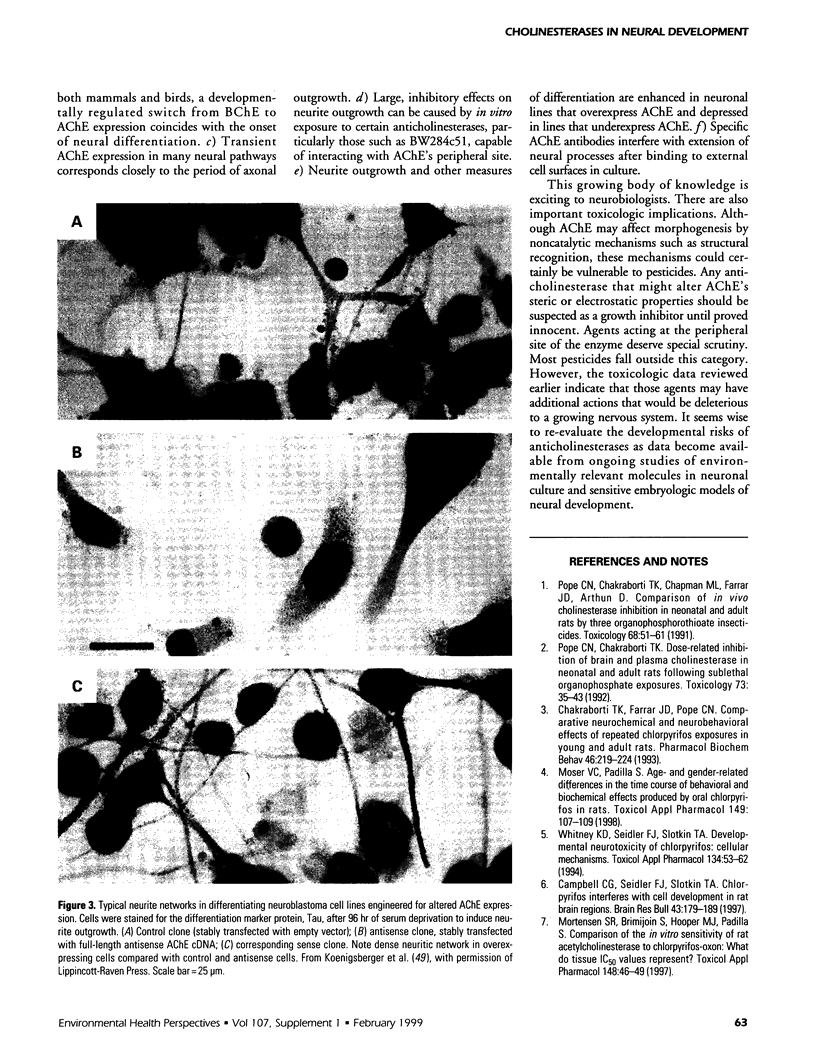
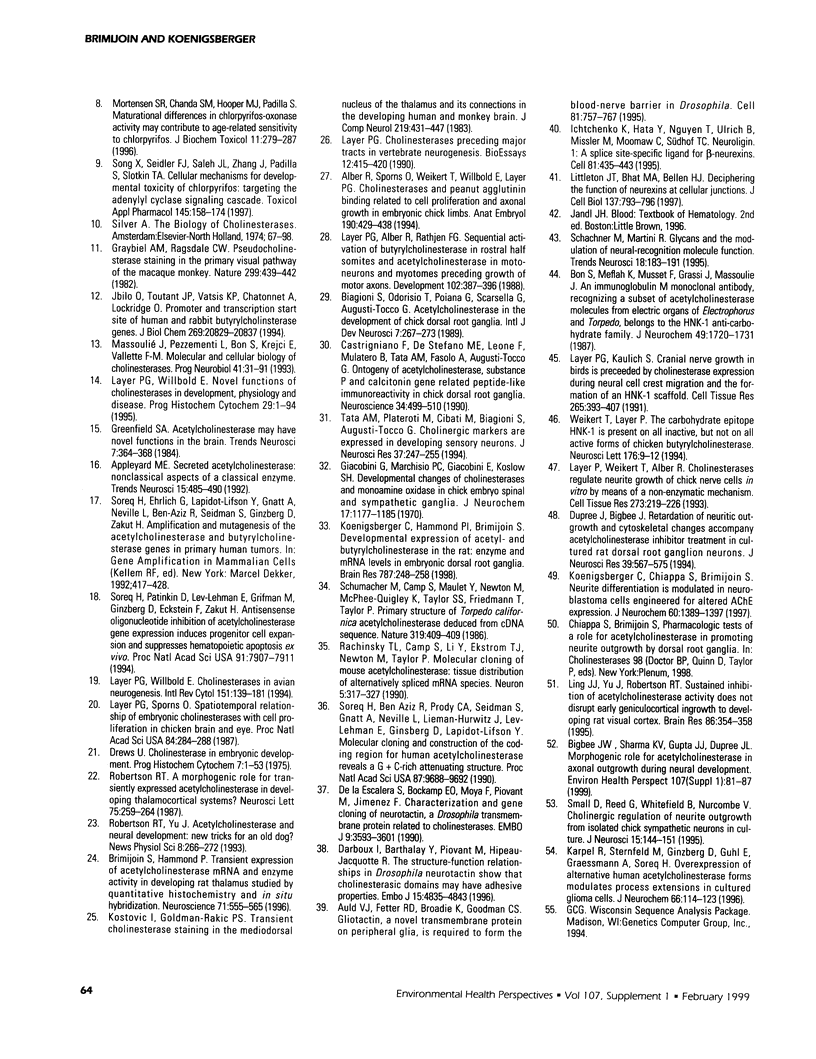
Images in this article
Selected References
These references are in PubMed. This may not be the complete list of references from this article.
- Alber R., Sporns O., Weikert T., Willbold E., Layer P. G. Cholinesterases and peanut agglutinin binding related to cell proliferation and axonal growth in embryonic chick limbs. Anat Embryol (Berl) 1994 Nov;190(5):429–438. doi: 10.1007/BF00235489. [DOI] [PubMed] [Google Scholar]
- Appleyard M. E. Secreted acetylcholinesterase: non-classical aspects of a classical enzyme. Trends Neurosci. 1992 Dec;15(12):485–490. doi: 10.1016/0166-2236(92)90100-m. [DOI] [PubMed] [Google Scholar]
- Auld V. J., Fetter R. D., Broadie K., Goodman C. S. Gliotactin, a novel transmembrane protein on peripheral glia, is required to form the blood-nerve barrier in Drosophila. Cell. 1995 Jun 2;81(5):757–767. doi: 10.1016/0092-8674(95)90537-5. [DOI] [PubMed] [Google Scholar]
- Biagioni S., Odorisio T., Poiana G., Scarsella G., Augusti-Tocco G. Acetylcholinesterase in the development of chick dorsal root ganglia. Int J Dev Neurosci. 1989;7(3):267–273. doi: 10.1016/0736-5748(89)90031-2. [DOI] [PubMed] [Google Scholar]
- Bigbee J. W., Sharma K. V., Gupta J. J., Dupree J. L. Morphogenic role for acetylcholinesterase in axonal outgrowth during neural development. Environ Health Perspect. 1999 Feb;107 (Suppl 1):81–87. doi: 10.1289/ehp.99107s181. [DOI] [PMC free article] [PubMed] [Google Scholar]
- Bon S., Méflah K., Musset F., Grassi J., Massoulié J. An immunoglobulin M monoclonal antibody, recognizing a subset of acetylcholinesterase molecules from electric organs of Electrophorus and Torpedo, belongs to the HNK-1 anti-carbohydrate family. J Neurochem. 1987 Dec;49(6):1720–1731. doi: 10.1111/j.1471-4159.1987.tb02429.x. [DOI] [PubMed] [Google Scholar]
- Brimijoin S., Hammond P. Transient expression of acetylcholinesterase messenger RNA and enzyme activity in developing rat thalamus studied by quantitative histochemistry and in situ hybridization. Neuroscience. 1996 Mar;71(2):555–565. doi: 10.1016/0306-4522(95)00457-2. [DOI] [PubMed] [Google Scholar]
- Campbell C. G., Seidler F. J., Slotkin T. A. Chlorpyrifos interferes with cell development in rat brain regions. Brain Res Bull. 1997;43(2):179–189. doi: 10.1016/s0361-9230(96)00436-4. [DOI] [PubMed] [Google Scholar]
- Castrignano F., De Stefano M. E., Leone F., Mulatero B., Tata A. M., Fasolo A., Augusti-Tocco G. Ontogeny of acetylcholinesterase, substance P and calcitonin gene-related peptide-like immunoreactivity in chick dorsal root ganglia. Neuroscience. 1990;34(2):499–510. doi: 10.1016/0306-4522(90)90158-z. [DOI] [PubMed] [Google Scholar]
- Chakraborti T. K., Farrar J. D., Pope C. N. Comparative neurochemical and neurobehavioral effects of repeated chlorpyrifos exposures in young and adult rats. Pharmacol Biochem Behav. 1993 Sep;46(1):219–224. doi: 10.1016/0091-3057(93)90344-s. [DOI] [PubMed] [Google Scholar]
- Darboux I., Barthalay Y., Piovant M., Hipeau-Jacquotte R. The structure-function relationships in Drosophila neurotactin show that cholinesterasic domains may have adhesive properties. EMBO J. 1996 Sep 16;15(18):4835–4843. [PMC free article] [PubMed] [Google Scholar]
- Drews U. Cholinesterase in embryonic development. Prog Histochem Cytochem. 1975;7(3):1–52. [PubMed] [Google Scholar]
- Dupree J. L., Bigbee J. W. Retardation of neuritic outgrowth and cytoskeletal changes accompany acetylcholinesterase inhibitor treatment in cultured rat dorsal root ganglion neurons. J Neurosci Res. 1994 Dec 1;39(5):567–575. doi: 10.1002/jnr.490390508. [DOI] [PubMed] [Google Scholar]
- Giacobini G., Marchisio P. C., Giacobini E., Koslow S. H. Developmental changes of cholinesterases and monoamine oxidase in chick embryo spinal and sympathetic ganglia. J Neurochem. 1970 Aug;17(8):1177–1185. doi: 10.1111/j.1471-4159.1970.tb03366.x. [DOI] [PubMed] [Google Scholar]
- Graybiel A. M., Ragsdale C. W., Jr Pseudocholinesterase staining in the primary visual pathway of the macaque monkey. Nature. 1982 Sep 30;299(5882):439–442. doi: 10.1038/299439a0. [DOI] [PubMed] [Google Scholar]
- Ichtchenko K., Hata Y., Nguyen T., Ullrich B., Missler M., Moomaw C., Südhof T. C. Neuroligin 1: a splice site-specific ligand for beta-neurexins. Cell. 1995 May 5;81(3):435–443. doi: 10.1016/0092-8674(95)90396-8. [DOI] [PubMed] [Google Scholar]
- Jbilo O., Toutant J. P., Vatsis K. P., Chatonnet A., Lockridge O. Promoter and transcription start site of human and rabbit butyrylcholinesterase genes. J Biol Chem. 1994 Aug 19;269(33):20829–20837. [PubMed] [Google Scholar]
- Karpel R., Sternfeld M., Ginzberg D., Guhl E., Graessmann A., Soreq H. Overexpression of alternative human acetylcholinesterase forms modulates process extensions in cultured glioma cells. J Neurochem. 1996 Jan;66(1):114–123. doi: 10.1046/j.1471-4159.1996.66010114.x. [DOI] [PubMed] [Google Scholar]
- Koenigsberger C., Chiappa S., Brimijoin S. Neurite differentiation is modulated in neuroblastoma cells engineered for altered acetylcholinesterase expression. J Neurochem. 1997 Oct;69(4):1389–1397. doi: 10.1046/j.1471-4159.1997.69041389.x. [DOI] [PubMed] [Google Scholar]
- Koenigsberger C., Hammond P., Brimijoin S. Developmental expression of acetyl- and butyrylcholinesterase in the rat: enzyme and mRNA levels in embryonic dorsal root ganglia. Brain Res. 1998 Mar 23;787(2):248–258. doi: 10.1016/s0006-8993(97)01507-2. [DOI] [PubMed] [Google Scholar]
- Kostovic I., Goldman-Rakic P. S. Transient cholinesterase staining in the mediodorsal nucleus of the thalamus and its connections in the developing human and monkey brain. J Comp Neurol. 1983 Oct 1;219(4):431–447. doi: 10.1002/cne.902190405. [DOI] [PubMed] [Google Scholar]
- Layer P. G., Alber R., Rathjen F. G. Sequential activation of butyrylcholinesterase in rostral half somites and acetylcholinesterase in motoneurones and myotomes preceding growth of motor axons. Development. 1988 Feb;102(2):387–396. doi: 10.1242/dev.102.2.387. [DOI] [PubMed] [Google Scholar]
- Layer P. G. Cholinesterases preceding major tracts in vertebrate neurogenesis. Bioessays. 1990 Sep;12(9):415–420. doi: 10.1002/bies.950120904. [DOI] [PubMed] [Google Scholar]
- Layer P. G., Kaulich S. Cranial nerve growth in birds is preceded by cholinesterase expression during neural crest cell migration and the formation of an HNK-1 scaffold. Cell Tissue Res. 1991 Sep;265(3):393–407. doi: 10.1007/BF00340862. [DOI] [PubMed] [Google Scholar]
- Layer P. G., Sporns O. Spatiotemporal relationship of embryonic cholinesterases with cell proliferation in chicken brain and eye. Proc Natl Acad Sci U S A. 1987 Jan;84(1):284–288. doi: 10.1073/pnas.84.1.284. [DOI] [PMC free article] [PubMed] [Google Scholar]
- Layer P. G., Weikert T., Alber R. Cholinesterases regulate neurite growth of chick nerve cells in vitro by means of a non-enzymatic mechanism. Cell Tissue Res. 1993 Aug;273(2):219–226. doi: 10.1007/BF00312823. [DOI] [PubMed] [Google Scholar]
- Layer P. G., Willbold E. Cholinesterases in avian neurogenesis. Int Rev Cytol. 1994;151:139–181. doi: 10.1016/s0074-7696(08)62632-7. [DOI] [PubMed] [Google Scholar]
- Layer P. G., Willbold E. Novel functions of cholinesterases in development, physiology and disease. Prog Histochem Cytochem. 1995;29(3):1–94. doi: 10.1016/s0079-6336(11)80046-x. [DOI] [PubMed] [Google Scholar]
- Ling J. J., Yu J., Robertson R. T. Sustained inhibition of acetylcholinesterase activity does not disrupt early geniculocortical ingrowth to developing rat visual cortex. Brain Res Dev Brain Res. 1995 May 26;86(1-2):354–358. doi: 10.1016/0165-3806(95)00035-c. [DOI] [PubMed] [Google Scholar]
- Littleton J. T., Bhat M. A., Bellen H. J. Deciphering the function of neurexins at cellular junctions. J Cell Biol. 1997 May 19;137(4):793–796. doi: 10.1083/jcb.137.4.793. [DOI] [PMC free article] [PubMed] [Google Scholar]
- Massoulié J., Pezzementi L., Bon S., Krejci E., Vallette F. M. Molecular and cellular biology of cholinesterases. Prog Neurobiol. 1993 Jul;41(1):31–91. doi: 10.1016/0301-0082(93)90040-y. [DOI] [PubMed] [Google Scholar]
- Mortensen S. R., Brimijoin S., Hooper M. J., Padilla S. Comparison of the in vitro sensitivity of rat acetylcholinesterase to chlorpyrifos-oxon: what do tissue IC50 values represent? Toxicol Appl Pharmacol. 1998 Jan;148(1):46–49. doi: 10.1006/taap.1997.8287. [DOI] [PubMed] [Google Scholar]
- Mortensen S. R., Chanda S. M., Hooper M. J., Padilla S. Maturational differences in chlorpyrifos-oxonase activity may contribute to age-related sensitivity to chlorpyrifos. J Biochem Toxicol. 1996;11(6):279–287. doi: 10.1002/(SICI)1522-7146(1996)11:6<279::AID-JBT3>3.0.CO;2-H. [DOI] [PubMed] [Google Scholar]
- Moser V. C., Padilla S. Age- and gender-related differences in the time course of behavioral and biochemical effects produced by oral chlorpyrifos in rats. Toxicol Appl Pharmacol. 1998 Mar;149(1):107–119. doi: 10.1006/taap.1997.8354. [DOI] [PubMed] [Google Scholar]
- Pope C. N., Chakraborti T. K., Chapman M. L., Farrar J. D., Arthun D. Comparison of in vivo cholinesterase inhibition in neonatal and adult rats by three organophosphorothioate insecticides. Toxicology. 1991;68(1):51–61. doi: 10.1016/0300-483x(91)90061-5. [DOI] [PubMed] [Google Scholar]
- Pope C. N., Chakraborti T. K. Dose-related inhibition of brain and plasma cholinesterase in neonatal and adult rats following sublethal organophosphate exposures. Toxicology. 1992;73(1):35–43. doi: 10.1016/0300-483x(92)90168-e. [DOI] [PubMed] [Google Scholar]
- Rachinsky T. L., Camp S., Li Y., Ekström T. J., Newton M., Taylor P. Molecular cloning of mouse acetylcholinesterase: tissue distribution of alternatively spliced mRNA species. Neuron. 1990 Sep;5(3):317–327. doi: 10.1016/0896-6273(90)90168-f. [DOI] [PubMed] [Google Scholar]
- Robertson R. T. A morphogenic role for transiently expressed acetylcholinesterase in developing thalamocortical systems? Neurosci Lett. 1987 Apr 10;75(3):259–264. doi: 10.1016/0304-3940(87)90531-3. [DOI] [PubMed] [Google Scholar]
- Schachner M., Martini R. Glycans and the modulation of neural-recognition molecule function. Trends Neurosci. 1995 Apr;18(4):183–191. doi: 10.1016/0166-2236(95)93899-9. [DOI] [PubMed] [Google Scholar]
- Schumacher M., Camp S., Maulet Y., Newton M., MacPhee-Quigley K., Taylor S. S., Friedmann T., Taylor P. Primary structure of Torpedo californica acetylcholinesterase deduced from its cDNA sequence. 1986 Jan 30-Feb 5Nature. 319(6052):407–409. doi: 10.1038/319407a0. [DOI] [PubMed] [Google Scholar]
- Small D. H., Reed G., Whitefield B., Nurcombe V. Cholinergic regulation of neurite outgrowth from isolated chick sympathetic neurons in culture. J Neurosci. 1995 Jan;15(1 Pt 1):144–151. doi: 10.1523/JNEUROSCI.15-01-00144.1995. [DOI] [PMC free article] [PubMed] [Google Scholar]
- Song X., Seidler F. J., Saleh J. L., Zhang J., Padilla S., Slotkin T. A. Cellular mechanisms for developmental toxicity of chlorpyrifos: targeting the adenylyl cyclase signaling cascade. Toxicol Appl Pharmacol. 1997 Jul;145(1):158–174. doi: 10.1006/taap.1997.8171. [DOI] [PubMed] [Google Scholar]
- Soreq H., Ben-Aziz R., Prody C. A., Seidman S., Gnatt A., Neville L., Lieman-Hurwitz J., Lev-Lehman E., Ginzberg D., Lipidot-Lifson Y. Molecular cloning and construction of the coding region for human acetylcholinesterase reveals a G + C-rich attenuating structure. Proc Natl Acad Sci U S A. 1990 Dec;87(24):9688–9692. doi: 10.1073/pnas.87.24.9688. [DOI] [PMC free article] [PubMed] [Google Scholar]
- Soreq H., Patinkin D., Lev-Lehman E., Grifman M., Ginzberg D., Eckstein F., Zakut H. Antisense oligonucleotide inhibition of acetylcholinesterase gene expression induces progenitor cell expansion and suppresses hematopoietic apoptosis ex vivo. Proc Natl Acad Sci U S A. 1994 Aug 16;91(17):7907–7911. doi: 10.1073/pnas.91.17.7907. [DOI] [PMC free article] [PubMed] [Google Scholar]
- Tata A. M., Plateroti M., Cibati M., Biagioni S., Augusti-Tocco G. Cholinergic markers are expressed in developing and mature neurons of chick dorsal root ganglia. J Neurosci Res. 1994 Feb 1;37(2):247–255. doi: 10.1002/jnr.490370210. [DOI] [PubMed] [Google Scholar]
- Weikert T., Layer P. G. The carbohydrate epitope HNK-1 is present on all inactive, but not on all active forms of chicken butyrylcholinesterase. Neurosci Lett. 1994 Jul 18;176(1):9–12. doi: 10.1016/0304-3940(94)90858-3. [DOI] [PubMed] [Google Scholar]
- Whitney K. D., Seidler F. J., Slotkin T. A. Developmental neurotoxicity of chlorpyrifos: cellular mechanisms. Toxicol Appl Pharmacol. 1995 Sep;134(1):53–62. doi: 10.1006/taap.1995.1168. [DOI] [PubMed] [Google Scholar]
- de la Escalera S., Bockamp E. O., Moya F., Piovant M., Jiménez F. Characterization and gene cloning of neurotactin, a Drosophila transmembrane protein related to cholinesterases. EMBO J. 1990 Nov;9(11):3593–3601. doi: 10.1002/j.1460-2075.1990.tb07570.x. [DOI] [PMC free article] [PubMed] [Google Scholar]



